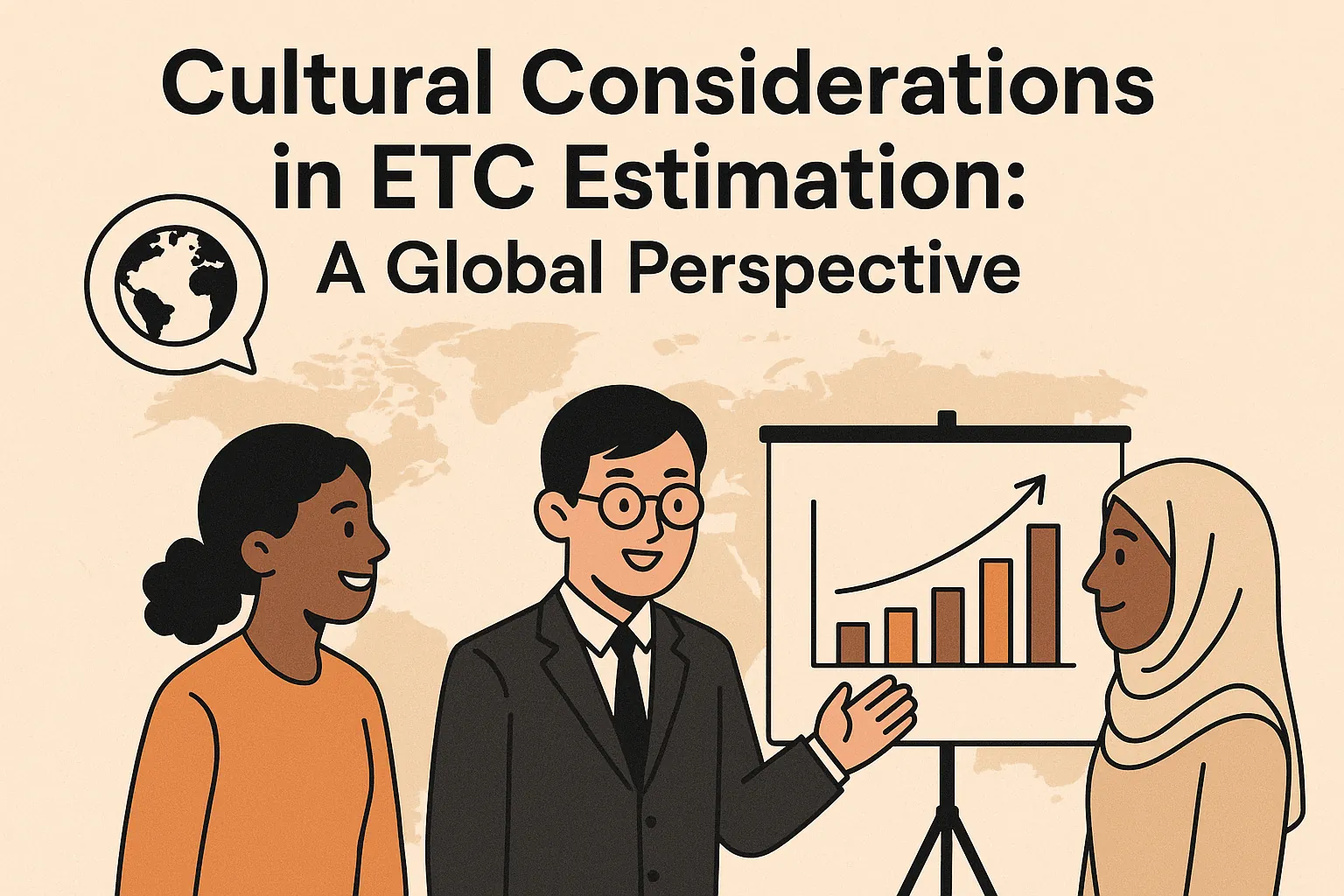Introduction to ETC in Project Management
The Estimate to Complete (ETC) is a crucial forecasting technique that provides project managers with an approximation of the costs required to finish the remaining work on a project. This metric is essential for maintaining control over project finances and ensuring that resources are allocated effectively. The ETC is calculated based on the current performance of the project and the actual costs incurred thus far, allowing project managers to make informed decisions about future expenditures and resource allocation [10][12].
Accurate estimation of ETC is vital for project success for several reasons:
- Resource Allocation: A precise ETC helps in determining whether the project has sufficient funds, time, and resources to complete the remaining tasks. This foresight is critical in avoiding budget overruns and ensuring that the project stays on track [5][11].
- Performance Monitoring: Regularly updating the ETC allows project managers to monitor project performance against the planned budget and timeline. This ongoing assessment can highlight potential issues early, enabling timely interventions [14].
- Stakeholder Communication: Clear and accurate ETC estimates facilitate better communication with stakeholders, providing them with a realistic view of project progress and financial health. This transparency is essential for maintaining trust and support from stakeholders [12][13].
As project managers navigate the complexities of global projects, it is essential to recognize the influence of cultural considerations on ETC estimation. Different cultures may approach project management practices, including estimation techniques, in varied ways. For instance, in some cultures, there may be a tendency to pad estimates to account for uncertainties, while others may prioritize directness and transparency in their communication [2][4]. Understanding these cultural nuances can significantly impact the accuracy of ETC estimations and overall project success.
Understanding Cultural Differences in Project Management
Particularly when estimating the Estimate to Complete (ETC), understanding cultural differences is crucial. Culture, in this context, refers to the shared values, beliefs, and practices that shape how individuals and groups interact within a professional environment. It encompasses various elements, including communication styles, decision-making processes, and management approaches, all of which can significantly influence project outcomes.
Defining Culture in Project Management
Culture plays a pivotal role in shaping the dynamics of project teams, especially in multicultural settings. It affects how team members perceive authority, collaborate, and resolve conflicts. Acknowledging these cultural nuances is essential for project managers to foster an inclusive environment that enhances team performance and project success. By recognizing the diverse cultural backgrounds of team members, project managers can tailor their strategies to accommodate different perspectives and working styles.
Hofstede’s Cultural Dimensions Theory
One of the most insightful frameworks for understanding cultural differences in project management is Hofstede’s Cultural Dimensions Theory. This theory identifies six dimensions that illustrate how cultural values impact behavior in a professional context:
- Power Distance: This dimension reflects the extent to which less powerful members of a society defer to more powerful ones. In high power distance cultures, hierarchical structures are respected, while low power distance cultures favor egalitarianism.
- Individualism vs. Collectivism: Individualistic cultures prioritize personal achievements and autonomy, whereas collectivist cultures emphasize group harmony and collective goals. This distinction can influence team dynamics and collaboration.
- Masculinity vs. Femininity: This dimension addresses the distribution of roles between genders. Masculine cultures value competitiveness and achievement, while feminine cultures prioritize relationships and quality of life.
- Uncertainty Avoidance: Cultures with high uncertainty avoidance prefer structured environments and clear rules, while those with low uncertainty avoidance are more comfortable with ambiguity and flexibility.
- Long vs. Short-Term Orientation: This dimension reflects the focus on future rewards versus immediate results. Cultures with a long-term orientation value perseverance and thrift, while short-term oriented cultures prioritize quick outcomes.
- Indulgence vs. Restraint: This dimension examines the degree to which societies allow for the gratification of desires. Indulgent cultures encourage enjoyment and leisure, while restrained cultures emphasize control and moderation.
Understanding these dimensions can help project managers navigate the complexities of multicultural teams and enhance their ETC estimations by aligning their approaches with the cultural values of their team members [1][15].
Influence of Cultural Values on Communication, Decision-Making, and Management Styles
Cultural values significantly influence how project teams communicate, make decisions, and manage tasks. For instance:
- Communication Styles: In high-context cultures, communication is often indirect and relies heavily on non-verbal cues, while low-context cultures favor direct and explicit communication. This difference can lead to misunderstandings if not properly managed.
- Decision-Making: In collectivist cultures, decisions may be made through consensus, valuing group input and harmony. Conversely, individualistic cultures may prioritize quick, decisive actions from leaders, which can create tension in a diverse team.
- Management Styles: Project managers must adapt their leadership styles to accommodate cultural preferences. For example, a participative management style may be more effective in collectivist cultures, while a directive approach might be preferred in high power distance cultures.
By recognizing and respecting these cultural differences, project managers can enhance collaboration, improve communication, and ultimately achieve more accurate ETC estimations, leading to successful project outcomes [2][4][10][12].
Cultural Influences on ETC Estimation
Particularly when it comes to estimating the costs and resources required to complete a project, understanding cultural influences is paramount. The Estimate to Complete (ETC) is a critical metric that can be significantly affected by cultural differences. Here, we explore how various cultural factors shape the approach to ETC estimation, focusing on risk tolerance, stakeholder engagement, and attitudes towards time.
1. Cultural Factors Affecting Risk Tolerance and Estimation Accuracy
Cultural backgrounds play a crucial role in shaping individuals’ risk tolerance levels. In cultures that prioritize collectivism, such as many Asian societies, there may be a greater emphasis on consensus and risk aversion. This can lead to more conservative estimates in ETC calculations, as project managers may prefer to under-promise and over-deliver to maintain group harmony and avoid potential conflicts. Conversely, in more individualistic cultures, like those in the United States, project managers might exhibit a higher tolerance for risk, leading to more aggressive estimates that reflect confidence in achieving project goals [1][2].
Moreover, the accuracy of ETC estimations can be influenced by cultural attitudes towards uncertainty. Cultures that embrace ambiguity may be more open to flexible and adaptive project management practices, allowing for adjustments in ETC as projects evolve. In contrast, cultures that favor structured approaches may require more detailed planning and risk assessments upfront, potentially leading to more rigid ETC estimates [3].
2. Variations in Stakeholder Engagement and Feedback Processes
Stakeholder engagement is another area where cultural differences manifest significantly. In cultures with high power distance, such as those found in many hierarchical societies, feedback may primarily flow from top management downwards. This can result in limited input from lower-level stakeholders, potentially skewing the ETC estimation process. Project managers in these environments may rely heavily on directives from senior leaders, which can lead to less accurate estimates if those leaders are not fully aware of on-the-ground realities [4].
In contrast, cultures that promote egalitarianism and open communication encourage broader stakeholder participation in the estimation process. This inclusive approach can enhance the accuracy of ETC by incorporating diverse perspectives and insights, ultimately leading to more reliable project forecasts. The ability to engage stakeholders effectively across different cultural contexts is essential for project managers aiming to refine their ETC estimations [5].
3. Cultural Attitudes Towards Time and Deadlines
Cultural perceptions of time significantly influence how ETC is estimated. In cultures that adhere to a monochronic view of time, such as in many Western countries, punctuality and strict adherence to deadlines are paramount. This perspective often leads to a more rigid approach to ETC, where project managers may feel pressured to meet specific timelines, potentially resulting in overly optimistic estimates that do not account for unforeseen delays [6].
Conversely, in polychronic cultures, where relationships and flexibility take precedence over strict schedules, project managers may adopt a more fluid approach to ETC estimation. In these contexts, deadlines may be viewed as guidelines rather than absolutes, allowing for adjustments based on project dynamics and stakeholder needs. This flexibility can lead to more realistic ETC estimates, as project managers are more likely to account for potential changes and uncertainties [7].
Case Studies: Global Perspectives on ETC Estimation
The estimation of the Estimate to Complete (ETC) is a critical component that can significantly influence project outcomes. However, cultural differences can play a pivotal role in shaping how ETC is approached and executed across various regions. This section presents case studies from diverse geographical contexts, highlighting both successful adaptations and failures due to cultural misunderstandings in ETC estimation.
1. North America: Emphasizing Transparency and Collaboration
In North America, project teams often prioritize transparency and open communication. A case study involving a large IT project in the United States demonstrated how cultural norms around collaboration led to effective ETC estimation. The project manager facilitated regular meetings where team members openly discussed their progress and challenges. This approach not only fostered trust but also allowed for more accurate ETC estimates, as team members felt comfortable sharing their concerns and insights. The success of this project underscored the importance of a collaborative culture in enhancing the accuracy of ETC estimations [5].
2. Asia: Navigating Hierarchical Structures
In contrast, a construction project in Japan illustrated the challenges posed by hierarchical cultural structures. The project team faced difficulties in obtaining accurate ETC estimates due to a reluctance among junior members to voice concerns or provide feedback to senior management. This cultural dynamic led to overly optimistic ETC estimates, which ultimately resulted in project delays and budget overruns. The case highlighted the need for project managers to adapt their communication strategies to encourage input from all team members, regardless of their position within the hierarchy [10].
3. Europe: Balancing Individualism and Collectivism
A project in Germany showcased how balancing individualistic and collectivist cultural traits can enhance ETC estimation. The project team comprised members from both individualistic cultures (e.g., the UK) and collectivist cultures (e.g., Italy). By recognizing these differences, the project manager implemented a dual approach: individual contributions were acknowledged, while also fostering a sense of team cohesion. This strategy led to more comprehensive ETC estimates, as team members felt valued both as individuals and as part of a collective effort. The project was completed on time and within budget, demonstrating the effectiveness of culturally sensitive practices [3][8].
4. Africa: Addressing Communication Barriers
In an infrastructure project in Ghana, cultural differences in communication styles posed significant challenges for ETC estimation. The project team consisted of members from various cultural backgrounds, leading to misunderstandings and misinterpretations of project requirements. The lack of clarity in communication resulted in inaccurate ETC estimates, which affected project timelines. To address this, the project manager organized workshops focused on cultural awareness and effective communication strategies. This initiative improved team dynamics and led to more accurate ETC estimations in subsequent phases of the project [11].
Strategies for Culturally Sensitive ETC Estimation
Particularly when estimating the Estimate to Complete (ETC), cultural considerations play a pivotal role. As project managers navigate diverse teams and stakeholders, understanding and integrating cultural differences can significantly enhance the accuracy and effectiveness of ETC estimations. Here are some practical strategies to promote culturally sensitive ETC estimation:
- Promote Cultural Awareness and Sensitivity: Cultivating cultural awareness within project teams is essential. This involves recognizing and understanding the differences and similarities between various cultures, which serves as the foundation for effective cross-cultural communication. By fostering an environment where team members appreciate and respect cultural differences, project managers can mitigate misunderstandings that may arise during the estimation process [12][13].
- Encourage Collaboration and Open Communication: Open lines of communication are crucial in multicultural settings. Project managers should create platforms for dialogue among diverse stakeholders, allowing team members to express their perspectives and assumptions regarding project timelines and resource needs. This collaborative approach not only enhances trust but also leads to more comprehensive and accurate ETC estimations, as it incorporates a variety of viewpoints and experiences [10][11].
- Implement Flexible Estimation Techniques: Different cultures may have varying approaches to time management and project execution. Therefore, it is beneficial to adopt flexible estimation techniques that can accommodate these differences. For instance, using a combination of quantitative and qualitative methods can help capture the nuances of cultural perspectives on project timelines. Techniques such as Delphi method or participatory estimation can be particularly effective, as they allow for input from all team members, ensuring that cultural contexts are considered in the final estimates [14][15].
By integrating these strategies into the ETC estimation process, project managers can enhance their ability to navigate cultural complexities, leading to more accurate and reliable project outcomes. Emphasizing cultural sensitivity not only improves project management practices but also fosters a more inclusive and collaborative work environment, ultimately contributing to project success in a global context.
Tools and Resources for Global Project Managers
Particularly when estimating the Estimate to Complete (ETC), cultural considerations play a crucial role. Understanding how cultural differences can influence project practices is essential for global project managers. Here are some tools and resources that can assist in navigating these complexities:
Project Management Software for Collaborative and Culturally Sensitive ETC Estimation
- Microsoft Project: This widely-used software includes features that facilitate collaboration among team members from diverse cultural backgrounds. It allows for real-time updates and shared resources, which can help in aligning team members’ expectations and communication styles.
- Asana: Asana is designed for team collaboration and project tracking. Its user-friendly interface and customizable workflows can accommodate various cultural approaches to project management, making it easier for teams to work together effectively.
- Trello: Trello’s card-based system allows teams to visualize tasks and progress. This visual approach can help bridge communication gaps that may arise from cultural differences, ensuring that all team members are on the same page regarding project timelines and responsibilities.
- Basecamp: Basecamp offers a centralized platform for project management that emphasizes clear communication and accountability. Its focus on transparency can help mitigate misunderstandings that may stem from cultural differences.
- Monday.com: This platform provides customizable workflows and visual project tracking, which can be particularly beneficial for teams with diverse cultural backgrounds. It allows for flexibility in how tasks are assigned and managed, accommodating different cultural work styles.
Cultural Competency Training Resources
- Cultural Intelligence (CQ) Training: This program focuses on developing the skills necessary to work effectively in culturally diverse environments. It offers workshops and online courses tailored for project managers.
- The Intercultural Development Inventory (IDI): The IDI provides assessments and training to enhance cultural competence. It helps project managers understand their own cultural perspectives and how to navigate those of their team members.
- Global Competence Certificate (GCC): Offered by various institutions, this certificate program equips project managers with the knowledge and skills to manage cross-cultural teams effectively.
Suggested Readings and Courses on Cross-Cultural Communication and Project Management
- “The Culture Map” by Erin Meyer: This book provides insights into how cultural differences impact communication and collaboration in a global business environment. It offers practical strategies for managing cross-cultural teams.
- “Cross-Cultural Management: Essential Concepts” by Nancy J. Adler: This text explores the impact of culture on management practices and provides frameworks for understanding and managing cultural differences in the workplace.
- Online Courses on Platforms like Coursera and edX: Look for courses on cross-cultural communication, global project management, and cultural competency. These platforms often feature courses from reputable universities that can enhance your understanding of cultural considerations in project management.
By leveraging these tools and resources, global project managers can enhance their cultural awareness and improve their ETC estimation processes, ultimately leading to more successful project outcomes. Understanding and respecting cultural differences is not just beneficial; it is essential in today’s interconnected world of project management.
Conclusion
In the context of Estimate to Complete (ETC) estimation, understanding cultural differences is paramount. As project managers navigate diverse global environments, they must recognize that cultural backgrounds significantly influence team dynamics, communication styles, and decision-making processes.
- Significance of Cultural Understanding: Acknowledging and respecting cultural differences can lead to more accurate estimations and improved project outcomes. Project managers who are culturally aware can better adapt their strategies to meet the unique needs and expectations of their team members, ultimately fostering a more collaborative and productive work environment. This cultural sensitivity not only enhances team cohesion but also mitigates potential misunderstandings that could derail project timelines and budgets [10][12].
- Incorporating Cultural Considerations: It is essential for project managers to actively incorporate cultural considerations into their practices. This can be achieved by employing multilingual team members, providing cultural training, and developing communication networks that respect and celebrate diversity. By embracing cultural differences rather than avoiding them, project managers can leverage the unique perspectives and strengths of their team members, leading to more innovative solutions and successful project completions [11][14].
In summary, cultural considerations are not merely an add-on to project management practices; they are integral to the success of ETC estimation and overall project execution. By prioritizing cultural awareness, project managers can drive better outcomes and create a more inclusive and effective project environment.
Find out more about Shaun Stoltz https://www.shaunstoltz.com/about/.
This post was written by an AI and reviewed/edited by a human.



